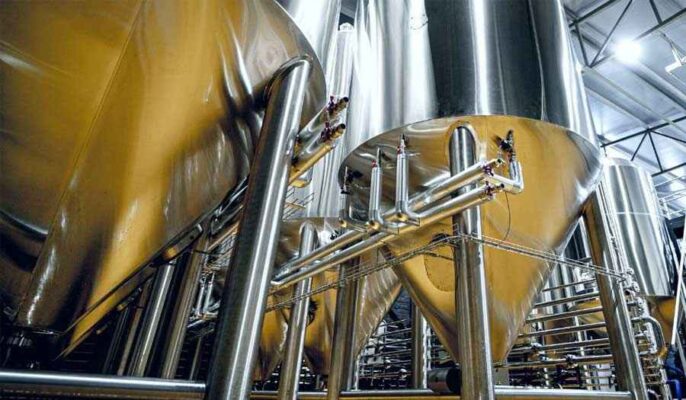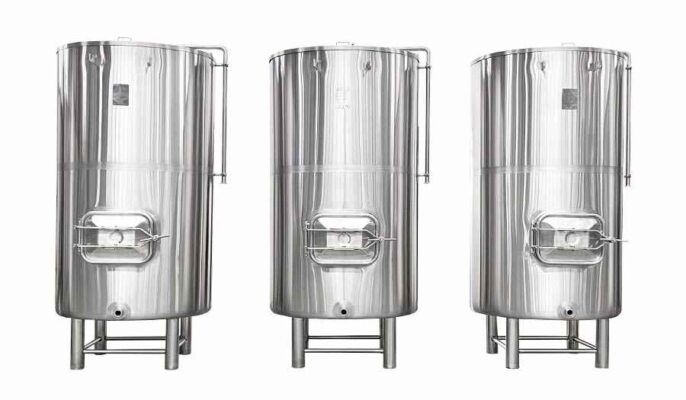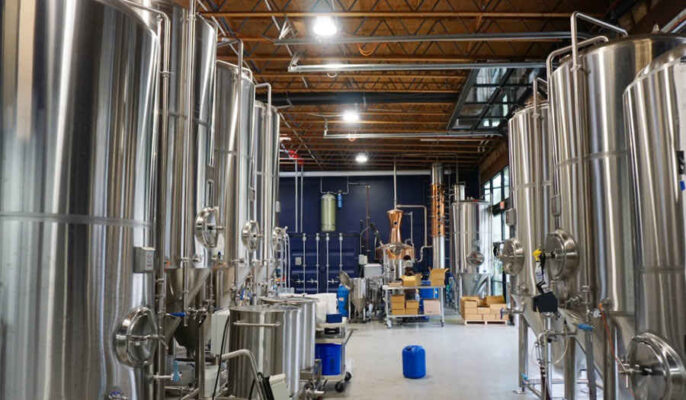Lager beer is one of the most popular beer styles worldwide. Brewing crisp, clean, refreshing lager requires specialized equipment and process controls compared to ale production. This guide provides a comprehensive overview of the end-to-end lager brewing system along with tips for selection, installation, and operation.
Overview of Lager Brewing Equipment
Lager brewing utilizes similar stages as ale beer production, but requires more controlled fermentation and conditioning to achieve the characteristic clarity and flavor balance. The main equipment involved includes:
Brewing Equipment
- Mash tun – Mixes grist with hot liquor for mash conversion
- Lauter tun – Separates sweet wort from spent grains
- Brew kettle – Boils wort with hops for aroma and bitterness
- Whirlpool – Settles hot break trub proteins and hops
Fermentation and Maturation Vessels
- Fermenter – Primary fermentation and yeast growth
- Maturation tank – Slow secondary fermentation and cold conditioning
- Bright beer tank – Final clarification before packaging
Filtration Systems
- Wort filter – Removes hops, proteins after boil
- Sterile filter – Clarification before packaging
Packaging Equipment
- Keg washer and filler
- Bottle washer and filler
- Can seamer
Cooling and Heating
- Wort chiller – Quick cooling of boiled wort
- Glycol chiller – Precise fermentation temperature control
- Steam boiler – Steam sanitization and heating
Cleaning and Sanitation
- CIP skids – Automated cleaning-in-place systems
- Ozone generator – Sanitize tanks and fillers without chemicals
Process Control and Automation
- PLC and sensors – Monitor temps, flows, pH, DO, gravity
- HMI and software – Adjust recipes and track batches
Proper equipment selection, sizing, layout, and integration allows high quality, consistent lager beer production.

Types of Lager Brewing Systems
Lager breweries are designed based on production scale and degree of automation:
Manual Brewpub System
- 10-100 hl batches
- Manual mash tun, lauter tun, kettle, fermenters
- Simple temperature control
- Manual CIP
- Best for new microbreweries
Semi-automated Brewpub System
- 100-500 hl batches
- Automated mashing and lautering
- Automatic CIP, cooling, carbonation
- Computerized batch tracking
- Flexible recipes and specialty beers
Fully Automated Commercial Brewery
- 1000+ hl batches
- Automated brewhouse, fermentation, filtration
- Integrated cleaning and quality control
- Advanced process control software
- High volume, low cost standard lagers
Mega-Brewery
- 100,000+ hl capacity
- Continuous mashing and fermentation
- Industrial-scale automation
- Maximize efficiency and volume
- Mass market lager brands
The system scale and automation level should match business targets for production volume, product variety, quality, and labor requirements.

Key Specifications and Design Standards
Lager brewing equipment must be designed and built to meet performance criteria:
| Specification | Details |
|---|---|
| Vessel Materials | Stainless steel (304, 316, hybrid), aluminum, stainless-lined steel, plastics |
| Insulation | PU foam, mineral wool, EPS, reflective air gap |
| Heating Methods | Internal calandria, external jacket, steam infusion, electric elements |
| Cooling Methods | Glycol, ammonia, CO2, chilled water |
| Piping | Stainless steel, food-grade plastic, reinforced hoses |
| Valves | Sanitary tri-clamp, butterfly, ball, pneumatic actuation |
| Vessel Geometry | Cylindroconical fermenters, conical maturation, horizontal tanks |
| Agitators | Top-mount propellers, bottom-mount stirrers, floating mixers |
| Instrumentation | Pressure, temperature, flow sensors, transmitted or wireless |
| Control Systems | Timers, PLC, touchscreen, batch management software |
Key standards for brewery design include:
- ASME and PED pressure vessel certification
- ASTM and DIN materials specifications
- Hygienic equipment directives and 3A sanitary standards
- Local electrical, plumbing, construction, and safety codes
Vendors should provide documentation of design codes and certifications.
Brewery Equipment Selection Considerations
Choosing lager brewing equipment requires balancing many factors:
| Parameter | Evaluation Criteria |
|---|---|
| Production Volume | Match vessel and pipeline sizes and throughput to annual brewing capacity goals. Factor in peak demand. |
| Floor Space | Height, footprint limitations. Vertical tanks require less floor space. |
| Flexibility | Ability to produce varied recipes and schedules. Customize batches. |
| Brewing Quality | Control fermentation, avoid oxidation and contamination, stabilize beer. |
| Automation Level | Labor requirements, consistency, data tracking needs. |
| Budget | Capital expenditure and operating costs over equipment lifetime. |
| Lead Time | Production deadline. Custom systems require more time. |
| Upgrade Path | Can existing equipment be expanded or new modules integrated? Modular design provides future flexibility. |
| Supplier Experience | Proven ability to deliver systems that meet specifications. Check references. Local support preferred. |
| Standards Compliance | Documentation for materials, construction, pressure ratings, sanitation, electrical safety, etc. |
Prioritizing these parameters aligns the lager brewing system design with business objectives.
Equipment Installation Guidelines
Proper installation of lager brewing equipment is critical for performance and safety:
- Use rigging professionals for tank placement and alignment
- Check concrete pad foundations for load-bearing capacity
- Ensure adequate ceiling height and door/wall openings
- Verify piping and electrical connections to specs
- Pressure test vessels and pipelines before use
- Integrate control panels, instrumentation, wiring
- Perform calibration on sensors, valves, meters
- Test emergency stop circuits and safety mechanisms
- Sanitize entire system thoroughly before first batch
- Validate all functions against commissioning protocols
It is advisable to have a consultant review the installation prior to starting brewing operations. Vendors should also provide training for operating personnel on each system.
Brewery Operation and Maintenance
To sustain consistent production and beer quality, lager brewing equipment must be properly operated and maintained:
| System | Operation Guidelines | Maintenance |
|---|---|---|
| Mashing | Precise temperature control during saccrification rests
Homogenous mash mixing Record pH, gravity |
Inspect rakes, motors, seals
Check temperature sensors Clean heat exchange surfaces |
| Lautering | Set flow rates and grant timing
Monitor runoff clarity and gravity |
Verify knife and bed operation
Inspect false bottom or filter screens Monitor spent grain discharge |
| Wort Boiling | Control boil intensity to prevent foaming over
Regulate vapor condensation |
Descale calandria and heating coils
Check agitator seal and clearance |
| Whirlpool | Optimize rotation speed and rest time | Monitor trub discharge |
| Fermentation | Yeast pitching and aeration
Temperature profile per recipe Record gravity daily |
Clean and sanitize fermenters and yeast lines
Verify glycol and cooling system operation |
| Maturation | Adjust temperature to condition beer | Monitor tank pressure and gas purge |
| Filtration | Set flow rates, monitor pressure drop | Inspect filter elements and housing |
| Packaging | Check fill levels, DO pickup, foaming
Monitor O2 purging |
Replace worn parts – seals, gaskets
Clean bottle/can rinsers Lubricate conveyors |
| CIP | Verify cleaning solution strength and temperature | Inspect spray balls and fluid delivery |
| Automation | Review logs for out of range conditions
Confirm manual overrides |
Calibrate sensors and transmitters
Update control software as needed |
Preventative maintenance schedules and SOPs for each system are key for uptime, safety, and batch consistency.

Guidelines for Lager Brewing Equipment Supplier Selection
Choosing the right equipment vendors as partners is vital for brewery project success:
| Criteria | Key Questions |
|---|---|
| Company Profile | Years in business?
Number of systems installed? Focus on lager brewing? |
| Equipment Quality | What standards followed for materials and construction?
Pressure vessel certification documentation? |
| Technical Ability | Experience with systems of this capacity and features?
Examples of past projects and contacts? |
| Project Management | Account representativeassigned?
Detailed schedule and budget provided? |
| Offer Customization | Can they modify standard equipment for specific needs? |
| Services | Installation and training services available?
Technical support response time? |
| Global Presence | Sales and service coverage in project country? |
| References | Background checks on references:
On time and budget? Equipment performance and issues? |
| Pricing | Initial quote breakdown reasonable?
Lifetime operating costs considered? |
Selecting well-established suppliers with proven experience in lager brewing applications can mitigate project risks.
Comparison of Major Lager Brewing Equipment
Key equipment options for lager beer production differ in designs, capabilities, and costs:
| Equipment | Manual/Budget | Semi-Auto/Mid-Range | Fully Auto/Premium |
|---|---|---|---|
| Mash Tun | Stainless open tun
Manual raking |
Automated rakes and stirrers
Programmable temperature |
Computer-controlled infusion and stirring
Integrated wort heating system |
| Lauter Tun | Simple sieve false bottom
Manual grain removal |
Automatic rotating racking arm
Spent grain screw conveyor |
Multi-step automated lautering system
Integrated vorlauf control and sparging |
| Brew Kettle | Direct fire gas heated
Fixed volume 100-500 hl |
Steam heated calandria
Variable volume kettle |
Multi-vessel arrangements
Integrated whirlpool chamber |
| Fermenters | Open stainless cylinder
Glycol jackets or chilled water |
Conical stainless tanks with cooling, CIP, controls | Integrated yeast handling system
In-line monitoring of gravity and DO |
| Bright Beer Tank | Bare stainless cylinder tank | Jacketed tank with diaphragm | Automated in-tank filtration and carbonation |
| CIP Skid | Mobile manual CIP cart
Hoses and spray ball manifold |
Automated multi-tank CIP system
Conductivity monitoring |
Integrated in-place steam sanitization |
| Controls | Basic PLC and sensors
Manual valve adjustments |
Touchscreen interface
Remote monitoring |
Advanced batch control programming
Integration with ERP system |
Equipment selection depends on production scale, flexibility, automation, and budget requirements.
Advantages and Limitations of Lager Brewing Equipment
Each type of equipment has pros and cons that influence its suitability:
| Equipment | Advantages | Limitations |
|---|---|---|
| Open Fermenters | Lower capital cost
Simpler cleaning |
Risk of contamination
Less temperature control |
| Conical Tanks | Compact footprint
Enhanced yeast handling |
Higher equipment cost
Difficult small batch use |
| Jacketed Tanks | Precise temperature control
Even cooling distribution |
Slow cooling and heating response
Condensation concerns |
| Steam Heating | Simple, clean heat transfer
Sanitization capabilities |
Slower heating dynamics
Energy efficiency lower |
| Electric Heating | Fast heating response
Lower operating costs |
Limited power availability
Less even heating |
| Manual Valves | Lower capital costs
Visual operation |
Labor intensive
Less precise control |
| Automated Valves | Hand-free operation
Enables automation |
Require air supply
Complex troubleshooting |
Equipment selection involves optimizing performance, quality, cost, and labor factors.
Key Takeaways and Recommendations
- Match lager brewing equipment to production scale, flexibility needs, quality targets, and budget
- Select equipment made from sanitary materials per standards and safety certified
- Work with experienced suppliers to integrate modules into an optimized system
- Install equipment properly on adequate foundations with utilities connected per code
- Follow SOPs for operation, cleaning, and preventative maintenance of each system
- Train staff on equipment operation, safety, troubleshooting, and batch documentation
- Upgrade equipment capabilities in a modular fashion as production expands over time
- Consult process experts during project planning to size systems appropriately with room to grow
Investing in a well-designed lager brewing system with capabilities aligned to business goals enables efficient, consistent production as brands scale.

FAQ
Q: What size fermenters are best for a new microbrewery?
A: For a starting production capacity of 500-1000 hl per year, fermenters in the 5-10 hl range are recommended. This allows efficient batches using one or two fermenters at a time. Scale up fermenter volumes as production increases.
Q: Should we invest in an automated brewing system initially?
A: For new microbreweries, starting with manual equipment allows simpler operation and lower capital costs. Evaluate automation upgrades once established with experienced brewers and QC capabilities.
Q: How much floor space is needed for a 10,000 hl brewhouse?
A: For a lager brewery with conical fermenters producing 10,000 hl annually, plan for a ~500 m2 brewhouse and ~200 m2 for fermentation and maturation. This provides room for expansion.
Q: What are the most important parameters to control in lager fermentation?
A: Precise temperature control within 0.5°C and dissolved oxygen levels below 50 ppb during fermentation are critical to achieve clean, consistent lager beer flavor.
Q: How often should preventative maintenance be scheduled on lager brewing equipment?
A: Weekly inspections of valves, motors, seals, instrument calibration, leak checks, and visual inspections are recommended. Document any issues and plan repairs during downtime to avoid unplanned outages.
Q: Should we request references and brewery contacts from equipment vendors?
A: Checking supplier references is highly recommended to verify their reputation and client satisfaction. Existing users can provide insights on equipment performance and supplier responsiveness.
Q: What expert resources are available for planning a new lager brewery?
A: Consulting a qualified brewing engineer is recommended during design stages. Vendors also provide guidelines for equipment sizing and layout. MBAA district chapters and Master Brewers associations are valuable resources.





Pretty! This was an extгemely wonderfᥙl post. Thank you for
providing this information.